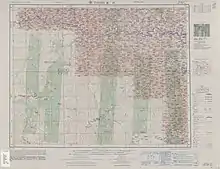Zhuxi County
Zhuxi County (simplified Chinese: 竹溪县; traditional Chinese: 竹谿縣; pinyin: Zhúxī Xiàn) is a county in the northwest of Hubei province, People's Republic of China, bordering Shaanxi to the west and Chongqing to the southwest. It is under the administration of the prefecture-level city of Shiyan. The county spans an area of 3,279 km2 (1,266 sq mi),[2] and has a population of 315,259 as of 2010.[1]
Zhuxi County
竹溪县 Chuki | |
|---|---|
 Zhuxi Location of the seat in Hubei | |
| Coordinates: 32°19′06″N 109°42′55″E | |
| Country | People's Republic of China |
| Province | Hubei |
| Prefecture-level city | Shiyan |
| Area | |
| • Total | 3,299 km2 (1,274 sq mi) |
| Population (2010)[1] | |
| • Total | 315,259 |
| • Density | 96/km2 (250/sq mi) |
| Time zone | UTC+8 (China Standard) |
| Website | www |
Toponymy
The name Zhuxi County is named for the Zhuxi River, whose name (Chinese: 竹溪河; Chinese: 竹溪河; pinyin: Zhúxī Hé; lit. 'bamboo stream river') was derived from the large amounts of bamboo forests which bordered both sides of the river.[1]
History
The area of present-day Zhuxi County once belong to the Chu State.[1] Part of the remains of the Great Wall of Chu, which possibly date back to the 3rd century BCE.[2]
Zhuxi County was established in 1476 under the reign of the Chenghua Emperor.[1]
In 1914, it was placed under the jurisdiction of Xiangyang Circuit.[1] In 1932, the Republic of China introduced Administrative Inspectorates, and the county was assigned to the 11th Administrative Inspectorate of Hubei Province.[1] In 1936, it was re-assigned to the 8th Administrative Inspectorate of Hubei Province.[1]
In 1949, under the People's Republic of China, Zhuxi County was assigned to Liangyun Prefecture, which was renamed to Yunyang Prefecture the following year.[1]
The county was moved to Xiangyang Prefecture in 1952, but was moved back to Yunyang Prefecture in 1965.[1]
In 1994, Zhuxi County was placed under the prefecture-level city of Shiyan, where it remains today.[1]
In 2010, Longba was upgraded from a township to a town.[1] In 2013, Bingying and Huiwan were upgraded from townships to towns.[1]
Geography
The county's geography is fairly mountainous, with its highest point reaching approximately 2,740 metres (8,990 ft) in height.[2] The county's main rivers are the Zhuxi River and the Huiwan River, which both flow into the larger Han River.[2]
Climate
Zhuxi County experiences an average annual temperature of 14 °C (57 °F), and an average annual precipitation of 1,000 millimetres (39 in).[2]
Administrative divisions

Zhuxi County is divided into eleven towns, four townships, and eight other township-level divisions.[3]
Its eleven towns are Chengguan, Jiangjiayan, Zhongfeng, Shuiping, Xianhe, Quanxi, Fengxi, Longba, Bingying, Huiwan, and Xinzhou.[3]
Its four townships are Eping Township, Tianbao Township, Taoyuan Township, and Xiangba Township.[3]
Its other township level divisions are Longwaya Tea Farm (Chinese: 龙王垭茶场), Guoying Zhuxi Comprehensive Farm (Chinese: 国营竹溪综合农场), Stock Seed Farm (Chinese: 原种场), Fishing Stock Farm (Chinese: 渔种场), Zhongxu Field (Chinese: 种畜场), Wangjiashan Tea Farm (Chinese: 王家山茶场), Biaohu Tree Farm (Chinese: 标湖林场), and Shuangzhu Tree Farm (Chinese: 双竹林场).[3]
Economy
Zhuxi County has sizable deposits of coal, limestone, and marble.[2] The county is also home to the most Taxus chinensis production of a county in China.[2]
References
- 竹溪县历史沿革 [Zhuxi County Historical Development]. 行政区划网 [www.xzqh.org] (in Chinese). 2014-08-01. Archived from the original on 2020-12-30. Retrieved 2020-12-30.
- 竹溪县概况地图 [Zhuxi County Overview]. 行政区划网 [www.xzqh.org] (in Chinese). 2014-08-01. Archived from the original on 2020-12-30. Retrieved 2020-12-30.
- 2020年统计用区划代码 [2020 Statistical Area Numbers and Rural-Urban Area Numbers] (in Chinese). National Bureau of Statistics of China. 2020. Archived from the original on 2020-12-30. Retrieved 2020-12-30.